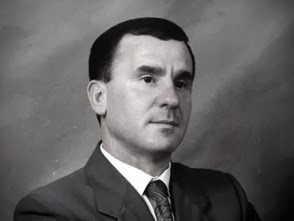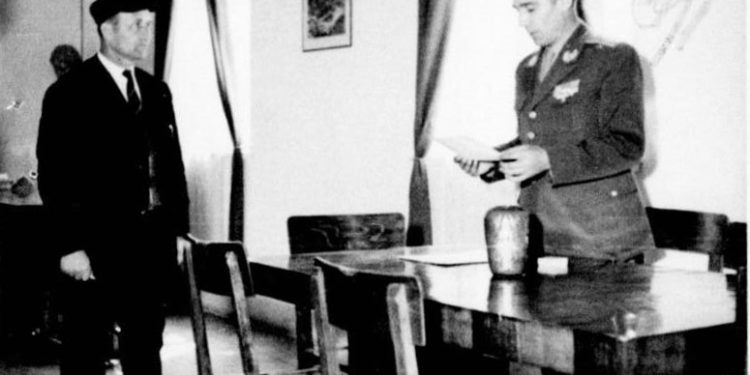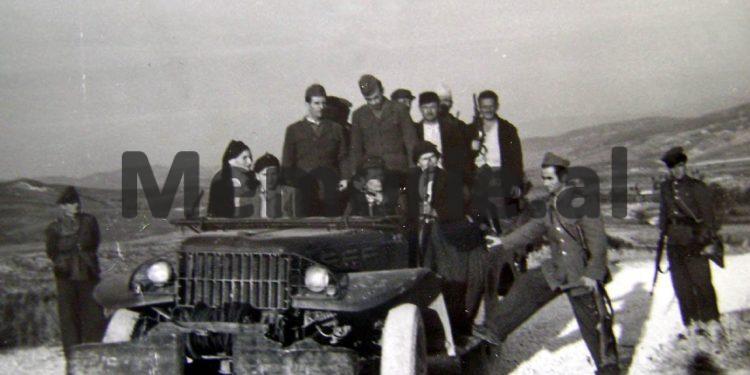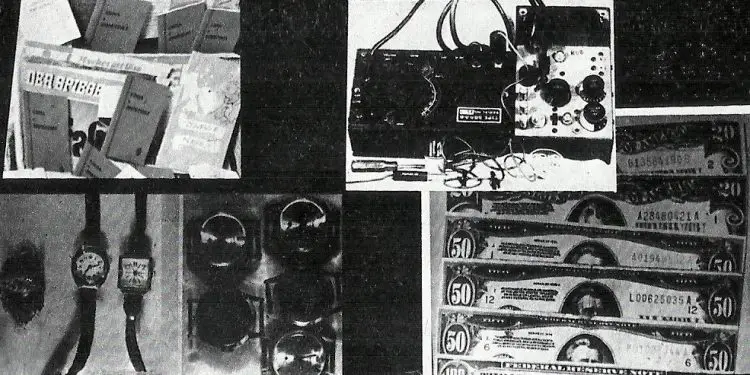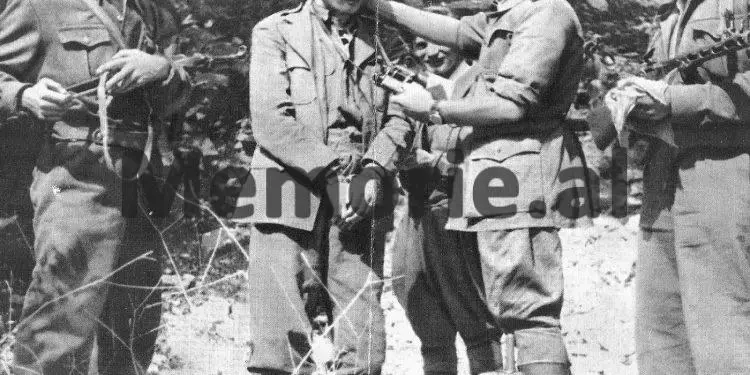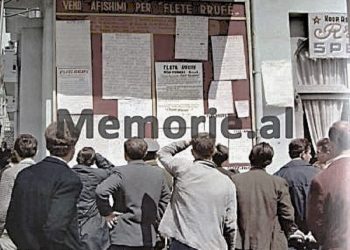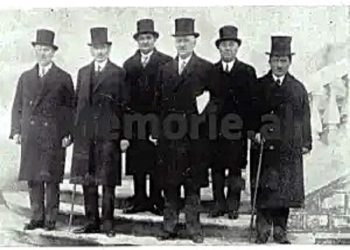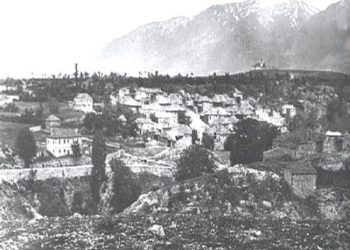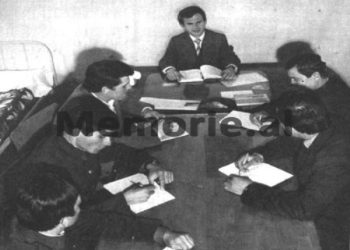Part One
– The unknown history of the anti-communist Hamit Toshi (Saiti), from Shkodra, who parachuted into Albania in 1949 –
Memorie.al / Many years ago, my friend, former political prisoner, Viktor Luka, while viewing the rich collection of photographs (an archive dedicated to anti-communist martyrs), spoke to me one by one about the names in the historical photos of the paratroopers in military uniform, who had dropped by parachute for secret anti-communist missions in Albania. They had all been trained in military camps in Italy by American and Italian personnel, and were sent on a mission to Enver Hoxha’s communist Albania, in cooperation with the “Free Albania” Committee, headquartered in New York. The original photos were kept as a rare relic by the Shkodran Zef Luka, Viktor’s brother.
Over 100 paratroopers landed in Albania at that time with special and very important tasks: to overthrow the communist regime and establish true freedom for the Albanian people. The book, in the form of a diary, by the paratrooper Zef Luka, is entitled: “One Hundred Eagles Who Came to Bring Freedom”. The deeper I delved into the labyrinths of the book by the Albanian-American Zef Luka, the more convinced I became that he and his friends (members of the anti-communist resistance paratrooper groups) who are no longer alive, such as Hamit Toshi (Saiti), were molded by noble ideals for Albania, being proud of the duty they had undertaken, even to the point of sacrificing their lives.
Events, people, places, words, and tragic circumstances parade through these pages in my mind. I had never read these simply described episodes, but they possess a Homeric epic quality, just as all sublime things have been and remain simple.
Their very sacrifice had a common, noble goal that was never extinguished: the awakening of the Albanian people’s dormant conscience, which was living a lethargic sleep. Worse still, a part of the youth supporting the violent Soviet dictatorship of the proletariat was intoxicated by the beautiful, lie-filled phrases of communism in Albania. Like a cancerous disease, it was slowly eating away at the national consciousness of its own people, who willingly or unwillingly submitted to the wildest violence of the communist dictatorship that lasted for almost 50 consecutive years in the scorched Albanian land.
The Generous Toshi Family and Hamit’s Parents
Saiti was a father and a friend to his son, whom he loved so much, just as his mother had rocked him in his cradle and nursed him with her love for the land where he was born, for his friends, comrades, and other relatives. She often caressed him even when little Hamit came home with other friends from the village, because he was very much loved by everyone. It was with these noble Albanian feelings that he grew up, always with the care of his three sisters, who live today: one in Ulcinj (Vladimir, in Montenegro), one in Trush, and one in Dajç in the Shkodra district.
This family, with many noble virtues of the Albanian tradition, was a great household. Hamit’s parents had six children, three sons and three daughters. As we learn from the family’s relatives, Muhamet was the eldest, then came Isuf, and finally the younger brother, Hamit, while their sisters were: Pashe in Trush, Cace in Ulcinj, and the youngest, Gjylana, in Dajç of Bregu i Bunës.
Early on, at the beginning of the 20th century, or more precisely in 1912, Saiti’s three brothers participated in the war of Tarabosh, in 1912, against the Montenegrin army, where Saiti himself and his wife were wounded. Later, due to the inflammation (infection) of the wound, he lost his life two years later. With the death of the father, Saiti, who was the pillar of the house, the family’s fragile economy began to worsen and deteriorate until the 1930s.
During the fascist occupation of the country on April 7, 1939, Muhamet fought the foreign occupiers with a weapon in hand. He always maintained good relations with the old Shkodran merchant families, such as the Muzhani, Myftia, Danhasani, Bianchi families, etc., at that time. Although not of the same economic level, he, like many Shkodran urban and rural families, kept the doors of hospitality open, a generosity that was and remains typical today, even among their great-grandchildren.
Public figures known in the city of Shkodra, such as Hasan Isufi and Caf Beg Ulqini, Prek Cali, etc., have occasionally been near their house. These individuals were exponents in the First Anti-Communist Movement in Eastern Europe, such as the one in the well-known village of Postribë (a few kilometers from the city of Shkodra) in 1946.
By leafing through some manuscripts and from the memories of members of the well-known Toshi tribe, we learn that a few months before fascist Italy capitulated, their house was surrounded to capture Hamit and Muhamet alive.
The “Liberation” of the Country and the Calamity of the Toshi Family’s suffering…!
The years 1944-1990 are precisely the most suspicious period, where communist historiography, yesterday and today, at all “cultural” levels in Albania, has been and continues to remain deficient in the “veracity” they have given to people’s lives. Those who were anti-communists have been constantly denigrated, which, unfortunately, continues even today by certain segments vested with power.
Perhaps it is a special case of expressing his human spirit: Hamit, on his own initiative, voluntarily goes to serve as a soldier, in order to prevent some young boys coming from the poorest families, who were the only sons in their families, from having to go.
The Toshi family now had a soldier son coming from Villgara, Ana e Malit – Oblikë. During the recruitment for soldiers, at Brahim Duli’s house, Hamit’s relative’s recall, the infamous military officer, Zoi Themeli, who at that time was the Head of the Internal Affairs Branch for Shkodra, called on them to surrender their weapons.
After they surrendered their weapons, they were instructed to go to the southern city of Gjirokastra, at a time when they were assigned to stay as soldiers in the village of Obot in Oblikë. Hamit Toshi, without any fear, openly opposed this unjust and very biased decision, which the Head of the Internal Branch, Zoi Themeli, personally issued to them. Among other things, Zoi Themeli told Hamit with contempt and mockery: “If you were a good man, you would not have surrendered your weapons!”
Maintaining his composure, Hamit immediately stepped out of the line, bent down, pulled a pistol from his sock, and threw it in front of Zoi Themeli’s eyes. He always carried up to three pistols with him. With the third pistol, he invited the communist officer, Zoi Themeli, to a duel, because an armed man is not insulted in the eyes of other men. With this courageous act, Hamit made all the soldiers stay in Obot for 6 months, and then they were transferred to Delvinë.
The First “Democratic” Elections, December 2, 1945
Hamit’s inextinguishable dream and desire was for a pluralistic Albanian homeland and society; a progressive and democratic Albania; the respect of the individual’s free vote; and the development of the country, following the model of the most advanced democratic countries of Western Europe and the free democracy of the United States of America, etc.
Even today, if you take a look at the history books currently in use, up to the Albanian political Universities, you will see that nothing has changed from the 50-year-old communist historiography, and that the elections of December 2, 1945, are mentioned as free voting and elections, when at that time the opposition voted with kernels in a separate box.
Thus, on December 2, 1945, Isuf was on the zonal commission at the polling station. One night before the voting took place, he was arrested by the Yugoslav UDB (State Security) and sent, with the help of the Albanian Security forces, to Ulcinj. At the request of Shefqet Hamza Duli, a Villogra resident (at that time the village council chairman), he was insisted upon and brought to the large prison in the city of Shkodra, held by the arms by two Yugoslav colonels.
The reason has remained an enigma even today. During the questioning by the investigator, Zoi Themeli, in the presence of the warden, Elez Mesi, and the two Yugoslav colonels, in the middle of a provocation, Isuf could not bear it any longer and addressed Zoi Themeli: “We have never seen any good from the Yugoslavs, not even to see it today.”
Meanwhile, the infamous Security officer, Zoi Themeli, told him to translate the phrase so that the Yugoslavs would also understand what it means in their Yugoslav language. Immediately, the foreign representatives were told that Isuf, as a bandit, sought to disrupt the Albanian-Yugoslav friendship.
At that moment, the wardens, along with their leader, Elez Mesi, tied Isuf up, laid him flat (down), and then the two Yugoslav colonels, with studded boots, one stepped on his head and the other on his stomach, and kept him in a state of torture for several minutes. Tortures in fascist forms and methods continued on other days, but Isuf never yielded. As fellow sufferers in prison, Isuf had well-known people in Albania, such as: Drita Kosturi, Terezina Pali, Father Mati Prenushi, Gulielm Suma (the owner of Kafja e Madhe), etc.
Seeing that they could not extract anything important from Isuf for the communist Security, just as they had done with other prisoners – so as not to release them due to lack of evidence, and because a conviction was necessary (an order from Mehmet Shehu and Enver Hoxha for all anti-communists)—the accusation was changed from disrupting Albanian-Yugoslav friendship to being an organizer or liaison for the Anti-Communist Movement of Postribë for the areas of Postribë, Shkodër, Ulqin, Krajë, and Ana e Malit.
Due to this, he was subjected again to various types of torture, inflicted by the most violent and heartless executioners. The cell where they stayed for a long time was about 1.5 meters wide and 2 meters long. All the shackled prisoners in the jail were tied to each other, with the last and the first being tied to the walls, so that they could not move. “One day,” recalls his nephew Xhevahir, “the warden Elez Mesi opened the cell’s hatch and looked at the prisoners.
Isuf was talking, and the warden listened. The warden took Isuf along with Father Mati Prenushi and took them to the black pit of the WC, where their toes could not touch the ground. He placed boiled eggs under his armpit, pine knots under his fingernails, and pushed them up to their waist in the black pit, to make them kneel, until both arrested men, tied up, fainted repeatedly from the tortures inflicted by the heartless men of the communist Security.”
Another day, when they came to, the respected Shkodran merchant, Guliam Suma, and the Catholic cleric, Father Mati Prenushi (1887-1948), in that difficult condition, requested that they be killed rather than be left alive in agony under the inhuman tortures carried out by the heartless executioner, Elez Mesi, and the others. Later, they were sentenced to death and executed by firing squads at the Rrmaj cemetery. Isuf, however, was released from prison in 1947. During his time in prison, Hamit (the younger brother) fled to Greece.
At this time, the calamity for his family began. The State Pursuit Forces and State Security (known at that time as the People’s Protection Section) immediately arrested Muhamet in 1949 and sentenced him on fabricated charges to 9 years of imprisonment, supposedly because he was going to assassinate a Security employee!
Before being imprisoned, Muhamet and some of his friends had helped the citizen Zija Myftia cross the state border, to escape the persecution of the communist regime. “Two years later, while my uncle was in prison,” Xhevahir continues in his memoirs, “he was killed in Dukagjin.”
Hamit Toshi’s Anti-Communist Activity
Returning once again to Zef Luka’s book, titled: “One Hundred Eagles Who Came to Bring Freedom” (Diary), he writes on its pages, among other things about Hamit, how he learned about the event of Hamit’s killing. Regarding this, he recalls: “Munellë. In the evening, we noticed that an airplane passed over us around eight o’clock. We thought it was dropping leaflets. The next day, the youth and the Security went out to collect them so they wouldn’t fall into the hands of the people, thus putting us also in danger. The next day, as soon as dawn broke, we heard rifles and machine guns.
I thought the army was doing maneuvers, but later I found out that paratroopers had been dropped in the Livadhet e Barit (Bar’s Meadows), in Cukal. They fought and were killed until they reached Kir. The group that had parachuted was from the “Free Albania” Committee. The paratrooper who was killed among them was my most loyal comrade, who had fled from the XV Assault Brigade, I Division, II Company of Delvinë: Hamit Toshi (Saiti), from Villgar, Ana e Malit, Shkodër. He also had a brother, whom I think was called Isuf, as well as a sister married in Ulcinj. Their lands were on the border with Yugoslavia” (Zef Luka, p. 95).
Thus, Hamit had parachuted as the fourth person, onto one of the meadows of Mount Cukal, but here too, he had fallen into an ambush. Apparently, the communist Security was aware beforehand of this landing by air of the paratrooper agents, who had been trained by the Americans at their bases in Italy, under the care of the “Free Albania” Committee headquartered in New York. The commander of the group was Hamit Toshi himself, who was accompanied on his noble mission by three other Albanian individuals. They were Hazis Rustja from Bërdica, Dedë Hila from Dukagjini, and Rifat Zyberaj. Memorie.al
Continues in the next issue





